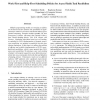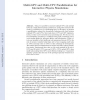790 search results - page 2 / 158 » Limits of Work-Stealing Scheduling |
IPPS
1999
IEEE
13 years 9 months ago
1999
IEEE
Executing subordinate activities by pushing return addresses on the stack is the most e cient working mode for sequential programs. It is supported by all current processors, yet i...
EUROPAR
2010
Springer
13 years 6 months ago
2010
Springer
Abstract. We study the problem of dynamic load-balancing on hierarchical platforms. In particular, we consider applications involving heavy communications on a distributed platform...
SPAA
1998
ACM
13 years 8 months ago
1998
ACM
In this paper we develop models for and analyze several randomized work stealing algorithms in a dynamic setting. Our models represent the limiting behavior of systems as the numb...
IPPS
2009
IEEE
13 years 12 months ago
2009
IEEE
Multiple programming models are emerging to address an increased need for dynamic task parallelism in applications for multicore processors and shared-address-space parallel compu...
EUROPAR
2010
Springer
13 years 5 months ago
2010
Springer
Today, it is possible to associate multiple CPUs and multiple GPUs in a single shared memory architecture. Using these resources efficiently in a seamless way is a challenging issu...


